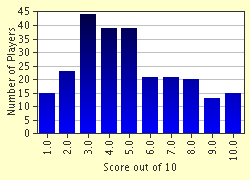Quiz Answer Key and Fun Facts
1. What is the difference between hurricanes and typhoons?
2. The Great Storm of 1900 caused numerous deaths and mainly affected which city?
3. At what wind speed does a tropical storm system reach hurricane strength?
4. In 2004, what rare hurricane-related weather phenomenon occured?
5. How many name lists are used in rotation for the Atlantic Hurricane season?
6. At one time, tropical storm systems were given exclusively female names. In what year did male names start appearing on the lists?
7. When is the Atlantic hurricane season?
8. When a tropical depression forms, it is closely monitored for any further development. When the sustained wind speeds reach a certain point, the system is then elevated to Tropical Storm status and it is given a name. At which wind speed does this occur?
9. Which of the following pairs of Atlantic hurricane names are the first ones to be retired?
10. In what year were names first officially assigned to Atlantic tropical systems?
Source: Author
robmeister
This quiz was reviewed by FunTrivia editor
crisw before going online.
Any errors found in FunTrivia content are routinely corrected through our feedback system.

